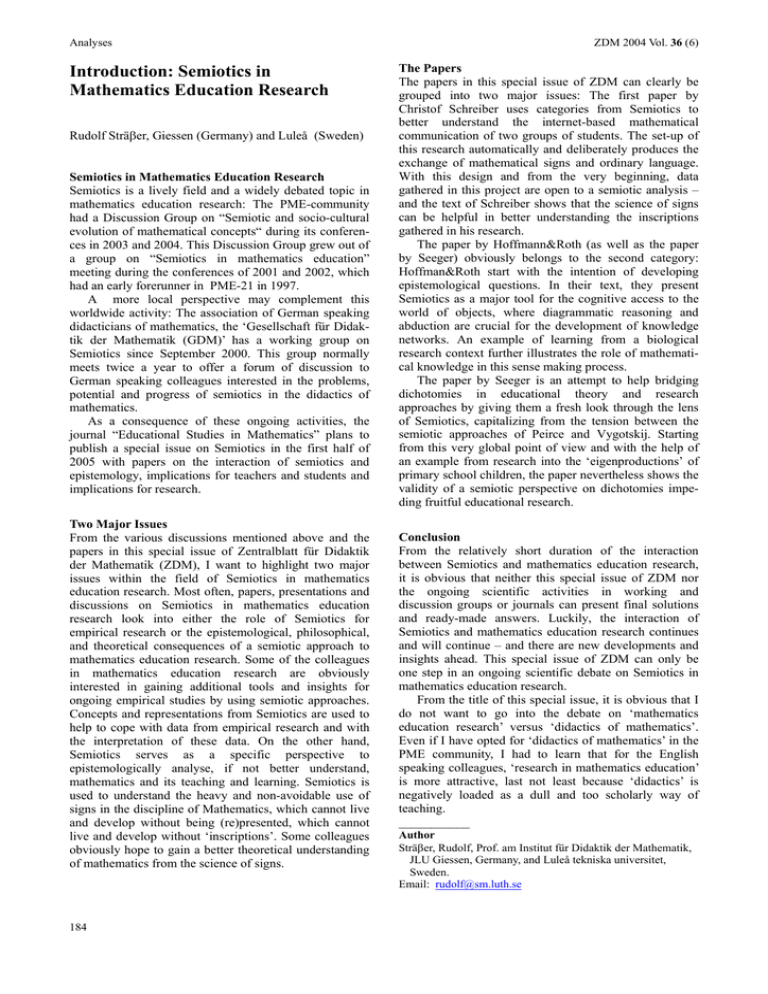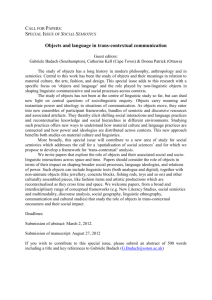Introduction: Semiotics in Mathematics Education Research
advertisement

Analyses Introduction: Semiotics in Mathematics Education Research Rudolf Sträβer, Giessen (Germany) and Luleå (Sweden) Semiotics in Mathematics Education Research Semiotics is a lively field and a widely debated topic in mathematics education research: The PME-community had a Discussion Group on “Semiotic and socio-cultural evolution of mathematical concepts“ during its conferences in 2003 and 2004. This Discussion Group grew out of a group on “Semiotics in mathematics education” meeting during the conferences of 2001 and 2002, which had an early forerunner in PME-21 in 1997. A more local perspective may complement this worldwide activity: The association of German speaking didacticians of mathematics, the ‘Gesellschaft für Didaktik der Mathematik (GDM)’ has a working group on Semiotics since September 2000. This group normally meets twice a year to offer a forum of discussion to German speaking colleagues interested in the problems, potential and progress of semiotics in the didactics of mathematics. As a consequence of these ongoing activities, the journal “Educational Studies in Mathematics” plans to publish a special issue on Semiotics in the first half of 2005 with papers on the interaction of semiotics and epistemology, implications for teachers and students and implications for research. Two Major Issues From the various discussions mentioned above and the papers in this special issue of Zentralblatt für Didaktik der Mathematik (ZDM), I want to highlight two major issues within the field of Semiotics in mathematics education research. Most often, papers, presentations and discussions on Semiotics in mathematics education research look into either the role of Semiotics for empirical research or the epistemological, philosophical, and theoretical consequences of a semiotic approach to mathematics education research. Some of the colleagues in mathematics education research are obviously interested in gaining additional tools and insights for ongoing empirical studies by using semiotic approaches. Concepts and representations from Semiotics are used to help to cope with data from empirical research and with the interpretation of these data. On the other hand, Semiotics serves as a specific perspective to epistemologically analyse, if not better understand, mathematics and its teaching and learning. Semiotics is used to understand the heavy and non-avoidable use of signs in the discipline of Mathematics, which cannot live and develop without being (re)presented, which cannot live and develop without ‘inscriptions’. Some colleagues obviously hope to gain a better theoretical understanding of mathematics from the science of signs. 184 ZDM 2004 Vol. 36 (6) The Papers The papers in this special issue of ZDM can clearly be grouped into two major issues: The first paper by Christof Schreiber uses categories from Semiotics to better understand the internet-based mathematical communication of two groups of students. The set-up of this research automatically and deliberately produces the exchange of mathematical signs and ordinary language. With this design and from the very beginning, data gathered in this project are open to a semiotic analysis – and the text of Schreiber shows that the science of signs can be helpful in better understanding the inscriptions gathered in his research. The paper by Hoffmann&Roth (as well as the paper by Seeger) obviously belongs to the second category: Hoffman&Roth start with the intention of developing epistemological questions. In their text, they present Semiotics as a major tool for the cognitive access to the world of objects, where diagrammatic reasoning and abduction are crucial for the development of knowledge networks. An example of learning from a biological research context further illustrates the role of mathematical knowledge in this sense making process. The paper by Seeger is an attempt to help bridging dichotomies in educational theory and research approaches by giving them a fresh look through the lens of Semiotics, capitalizing from the tension between the semiotic approaches of Peirce and Vygotskij. Starting from this very global point of view and with the help of an example from research into the ‘eigenproductions’ of primary school children, the paper nevertheless shows the validity of a semiotic perspective on dichotomies impeding fruitful educational research. Conclusion From the relatively short duration of the interaction between Semiotics and mathematics education research, it is obvious that neither this special issue of ZDM nor the ongoing scientific activities in working and discussion groups or journals can present final solutions and ready-made answers. Luckily, the interaction of Semiotics and mathematics education research continues and will continue – and there are new developments and insights ahead. This special issue of ZDM can only be one step in an ongoing scientific debate on Semiotics in mathematics education research. From the title of this special issue, it is obvious that I do not want to go into the debate on ‘mathematics education research’ versus ‘didactics of mathematics’. Even if I have opted for ‘didactics of mathematics’ in the PME community, I had to learn that for the English speaking colleagues, ‘research in mathematics education’ is more attractive, last not least because ‘didactics’ is negatively loaded as a dull and too scholarly way of teaching. ___________ Author Sträβer, Rudolf, Prof. am Institut für Didaktik der Mathematik, JLU Giessen, Germany, and Luleå tekniska universitet, Sweden. Email: rudolf@sm.luth.se



